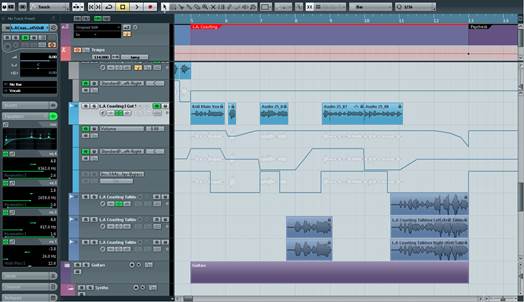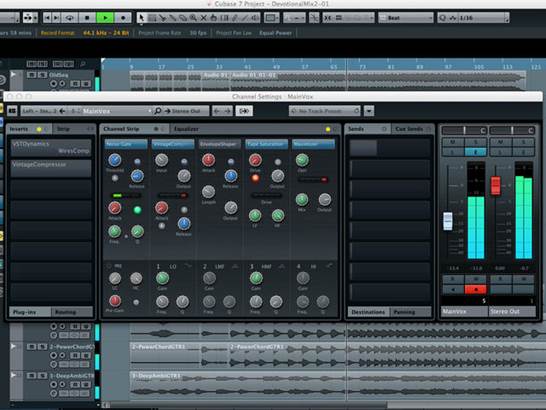Less than a year after an
action-packed point update, this popular DAW makes the leap to version 7,
focusing on creativity and workflow
A year ago brought us Cubase 6.5, a mere
point release, yet one stuffed full of new goodies including two of the best
instruments the company have ever bundled in. Unusually, this was a paid-for
point update, but it followed in the footsteps of Steinberg’s established full
version update formula: a handful of new instruments and effects, some nips,
some tucks and a few eye-popping features. Steinberg’s updates have, of late,
been designed to open users’ wallets with the promise of creative inspiration,
while rarely delivering the sort of sweeping changes that would rattle them or
have them scrambling to the user manual.

Steinberg
Cubase 7
But times have changed in the DAW scene,
with some competitors offering quite radical updates - see Propeller head’s
introduction of full audio editing/recording and plugin Rack Extensions to
Reason, or Cakewalk’s deep rework of Sonar as Sonar X1. Elsewhere, you have
newcomers like PreSonus Studio One and even the upcoming Bitwig Studio that are
not tied down to years of established convention.
Some might say that Cubase has been looking
slightly stodgy in comparison; others might champion its familiarity. If you're
in the latter camp, you may be taken aback by some of the sweeping changes that
have come to Cubase in this new version. However, we've been spending a lot of
time with it and can assure you that the new features are nothing short of
inspirational.
Remixed remodeled
There are tons of new features in Cubase -
far too many to cover in our three pages. Of those that demand specific
attention, the new Mix Console is probably at the top of the list. Yep, Cubase
7's new mixer is so drastically different from the previous version that
they’ve seen fit to rename it. A few minutes of poking around reveals that this
is indeed an entirely new concept for Cubase and one that, frankly, makes the
old mixer seem like a limited relic, albeit a slightly more immediate one.

The
new Mix Console is probably at the top of the list
That old mixer was relatively fixed. You
could collapse the bits you didn’t want to see, toggle showing inserts, EQs,
sends, etc, and you could have three different mixers available at any time.
However, for the most part, the size of all of these elements wasn’t
adjustable. The new Mix Console is entirely configurable and can be expanded to
fill your entire screen. The Visibility/Zones column enables you to decide not
just which channels you want to see but in what order they should be arranged.
You can show (and grow) only the fader sections, for instance, or toggle a
notepad for each channel, channel overview and more. Old tools like in-line EQ
curves and large meters are still available.
Strip tease
The new Channel Strip isn’t just an element
of the Mix Console but is also available when viewing the Channel Settings
window. In fact, we prefer accessing it this way as it gives a better overview
than the narrow vertical display in the Mix Console, enabling you to see all
its five sections at once without scrolling. You can arrange them in any order
you like; some offer variations on a theme, while others do one job.

The
new Channel Strip isn’t just an element of the Mix Console but is also
available when viewing the Channel Settings window.
The Noise Gate comes first, with its
Threshold, Attack, Release, Freq and Q controls -just enough to do the job in a
hurry. There’s also a Saturation section, offering Tube and Tape modes, both of
which give you control over drive, output and low- / high-pass filtering. Then
there's an Envelope Shaper with - as you’d expect - Attack and Release knobs,
along with Length and Output controls.
The Compressor section provides Tube,
Vintage, and Standard models, each with its own collection of controls. The one
that impressed us most was the Vintage - although it offers only Attack,
Release, Input and Output controls, this simplicity is what we found so appealing.
In addition to the compressors, there’s an entirely separate section for
limiting. This one provides Brickwall Limiter, Maximizer and Standard Limiter
models, each with only the barest set of parameters. Again, it’s this
simplicity that appeals, and it’s seen yet again in the four-band EQ, which can
be placed anywhere in the signal flow. With just the bare essentials on hand
for each band, the EQ makes simple work of dialing in just the right amount of
boost or attenuation. And that's the point: hosting a set of the most-used
processing on each channel for immediate access. No digging through plugins or
toggling GUIs - just get in, get the job done and make it sound good. You can
draw upon a collection of Channel Strip presets, some of which were designed by
US rock producer Allen Morgan.
|
Info
§ Price:
$717
Verdict
§ For Mixer revamped at long last
Channel Strip rocks! Chord Track/Assistant are inspirational VST Connect SE
for remote recording CurveEQ is a crash course in mixing
§ Against No mixer/plugin undo!
Overstuffed MixConsole needs scrolling VST Connect SE video can be flaky Snow
Leopard users will need to update
§ An
excellent update, bringing yet more power, quality and Innovation to Cubase
|